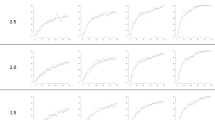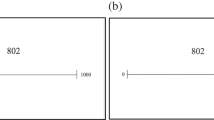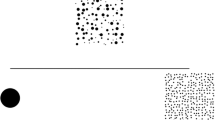Abstract
The left digit effect in number line estimation refers to the phenomenon where numerals with similar magnitudes but different leftmost digits (e.g., 19 and 22) are estimated to be farther apart on a number line than is warranted. The effect has been studied using a bounded number line task, a task in which a line is bounded by two endpoints (e.g., 0 and 100), and where one must indicate the correct location of a target numeral on the line. The goal of the present work is to investigate the left digit effect in an unbounded number line task, a task that involves using the size of one unit to determine a target numeral’s location, and that elicits strategies different from those used in the bounded number line task. In a preregistered study, participants (N = 58 college students) completed four blocks of 38 trials each of an unbounded number line task, with target numerals ranging between 0 and 100. We found a medium and statistically reliable left digit effect (d = 0.70). The study offers further evidence that the effect is not driven by response strategies specific to the bounded number line task. We discuss other possible sources of the effect including conversion of symbols to magnitudes in these and other contexts.




Similar content being viewed by others
Availability of data and materials
Data are available at: https://osf.io/gru4w/?unbounded_number_line_data.
Code availability
No code is available for this study.
Notes
The strategy used to perform the task is also often referred to as a subtraction-division strategy because either of these arithmetic skills can be used to place the target in relation to the two boundary values.
One might expect this bias to be negatively accelerating, especially based on some past work with children (e.g., Siegler & Opfer, 2003). However, this is not what is typically found for adults once task strategy is considered and experimental bias is reduced (e.g., Cohen & Blanc-Goldhammer, 2011; see Cohen & Ray, 2020, for discussion).
Put differently, this means estimating the length of 10 units, then estimating the length of 24 units, and then adding the second length to the end of the first length. It does not mean iterating by single units.
As in past work (e.g., Williams et al., 2022b), the boundary of ‘10’ was not used in left digit analyses, in case single-digit target numerals (numerals below the boundary) are evaluated differently than two-digit ones.
Using the formula of Cohen and Ray (2020), we calculated that a canvas of the size we used (5,011 × 2,771 px) with a starting point at 327 px, unit lines 4 px wide, and a unit width of a maximum of 14 px, could accommodate a 0–108 number line task (i.e., larger than the 0–100 line used here), assuming accelerating bias of β = 1.2.
In this example, as with some proposed models, it is the underweighting of the rightward digit that leads to the relative overweighting of the leftmost digit (rather than a direct overweighting of the leftmost digit).
References
Barth, H., & Paladino, A. M. (2011). The development of numerical estimation: Evidence against a representational shift. Developmental Science, 14(1), 125–135. https://doi.org/10.1111/j.1467-7687.2010.00962.x
Booth, J. L., & Siegler, R. S. (2006). Developmental and individual differences in pure numerical estimation. Developmental Psychology, 42(1), 189–201. https://doi.org/10.1037/0012-1649.41.6.189
Brysbaert, M. (1995). Arabic number reading: On the nature of the numerical scale and the origin of phonological recoding. Journal of Experimental Psychology: General, 124(4), 434–452. https://doi.org/10.1037/0096-3445.124.4.434
Choi, J., Li, Y. L., & Samper, A. (2019). The influence of health motivation and calorie ending on preferences for indulgent foods. Journal of Consumer Research, 46(3), 606–619. https://doi.org/10.1093/jcr/ucz002
Cohen, D. J., & Blanc-Goldhammer, D. (2011). Numerical bias in bounded and unbounded number line tasks. Psychonomic Bulletin & Review, 18(2), 331–338. https://doi.org/10.3758/s13423-011-0059-z
Cohen, D. J., & Quinlan, P. T. (2018). The log–linear response function of the bounded number-line task is unrelated to the psychological representation of quantity. Psychonomic Bulletin & Review, 25(1), 447–454. https://doi.org/10.3758/s13423-017-1290-z
Cohen, D. J., & Ray, A. (2020). Experimental bias in number-line tasks and how to avoid them: Comment on Kim and Opfer (2017) and the introduction of the Cohen Ray number-line task. Developmental Psychology, 56(4), 846–852. https://doi.org/10.1037/dev0000761
Cohen, D. J., & Sarnecka, B. W. (2014). Children’s number-line estimation shows development of measurement skills (not number representations). Developmental Psychology, 50(6), 1640–1652. https://doi.org/10.1037/a0035901
Cohen, D. J., Blanc-Goldhammer, D., & Quinlan, P. T. (2018). A mathematical model of how people solve most variants of the number-line task. Cognitive Science, 42(8), 2621–2647. https://doi.org/10.1111/cogs.12698
Dehaene, S., Dupoux, E., & Mehler, J. (1990). Is numerical comparison digital? Analogical and symbolic effects in two-digit number comparison. Journal of Experimental Psychology: Human Perception and Performance, 16(3), 626–641. https://doi.org/10.1037/0096-1523.16.3.626
Dehaene, S., Izard, V., Spelke, E., & Pica, P. (2008). Log or linear? Distinct intuitions of the number scale in Western and Amazonian indigene cultures. Science, 320, 1217–1220. https://doi.org/10.1126/science.1156540
Dotan, D., & Dehaene, S. (2013). How do we convert a number into a finger trajectory? Cognition, 129(3), 512–529. https://doi.org/10.1016/j.cognition.2013.07.007
Dotan, D., & Dehaene, S. (2020). Parallel and serial processes in number-to-quantity conversion. Cognition, 204, 104387. https://doi.org/10.1016/j.cognition.2020.104387
Garcia-Orza, J., Estudillo, A. J., Calleja, M., & Rodriguez, J. M. (2017). Is place-value processing in four-digit numbers fully automatic? Yes, but not always. Psychonomic Bulletin & Review, 24(6), 1906–1914. https://doi.org/10.3758/s13423-017-1231-x
Henninger, F., Shevchenko, Y., Mertens, U., Kieslich, P. J., & Hilbig, B. E. (2019). lab.js: A free, open, online study builder. PsyArXiv. https://doi.org/10.31234/osf.io/fqr49
Hollands, J. G., & Dyre, B. P. (2000). Bias in proportion judgments: The cyclical power model. Psychological Review, 107(3), 500–524. https://doi.org/10.1037/0033-295X.107.3.500
Kallai, A. Y., & Tzelgov, J. (2012). The place-value of a digit in multi-digit numbers is processed automatically. Journal of Experimental Psychology: Learning, Memory, and Cognition, 38(5), 1221–1233. https://doi.org/10.1037/a0027635
Kayton, K., Williams, K., Stenbaek, C., Gwiazda, G., Bondhus, C., Green, J., Fischer, G., Barth, H., & Patalano, A. L. (2022). Summary accuracy feedback and the left digit effect in number line estimation. Memory & Cognition, 50(8), 1789–1803. https://doi.org/10.3758/s13421-022-01278-2
Kim, D., & Opfer, J. E. (2017). A unified framework for bounded and unbounded numerical estimation. Developmental Psychology, 53(6), 1088–1097. https://doi.org/10.1037/dev0000305
Lacetera, N, Pope, D. G., & Sydnor, J. R. (2012). Heuristic thinking and limited attention in the car market. American Economic Review, 102(5), 2206–2236. https://doi.org/10.1257/aer.102.5.2206
Lai, M., Zax, A., & Barth, H. (2018). Digit identity influences numerical estimation in children and adults. Developmental Science, 21(5), e12657. https://doi.org/10.1111/desc.12657
McCloskey, M. (1992). Cognitive mechanisms in numerical processing: Evidence from acquired dyscalculia. Cognition, 44(1–2), 107–157. https://doi.org/10.1016/0010-0277(92)90052-J
McCloskey, M., Sokol, S. M., & Goodman, R. A. (1986). Cognitive processes in verbal-number production: Inferences from the performance of brain-damaged subjects. Journal of Experimental Psychology: General, 115(4), 307–330. https://doi.org/10.1037/0096-3445.115.4.307
Moeller, K., Huber, S., Nuerk, H. C., & Willmes, K. (2011). Two-digit number processing: holistic, decomposed or hybrid? A computational modelling approach. Psychological Research, 75(4), 290–306. https://doi.org/10.1007/s00426-010-0307-2
Nuerk, H. C., & Willmes, K. (2005). On the magnitude representations of two-digit numbers. Psychology Science, 47(1), 52–72.
Nuerk, H. C., Moeller, K., & Willmes, K. (2015). Multi-digit number processing: Overview, conceptual clarifications, and language influences. In C. Kadosh & A. Dowker (Eds.), The Oxford Handbook of Numerical Cognition (pp. 106–139). Oxford University Press.
Nuerk, H. C., Weger, U., & Willmes, K. (2001). Decade breaks in the mental number line? Putting the tens and units back in different bins. Cognition, 82(1), B25–B33. https://doi.org/10.1016/S0010-0277(01)00142-1
Olenski, A. R., Zimerman, A., Coussens, S., & Jena, A. B. (2020). Behavioral heuristics in coronary-artery bypass graft surgery. New England Journal of Medicine, 382(8), 778–779. https://doi.org/10.1056/NEJMc1911289
Opfer, J. E., Thompson, C. A., & Kim, D. (2016). Free versus anchored numerical estimation: A unified approach. Cognition, 149, 11–17. https://doi.org/10.1016/j.cognition.2015.11.015
Patalano, A. L., Zax, A., Williams, K., Mathias, L., Cordes, S., & Barth, H. (2020). Intuitive symbolic magnitude judgments and decision making under risk in adults. Cognitive Psychology, 118, 101273. https://doi.org/10.1016/j.cogpsych.2020.101273
Patalano, A. L., Williams, K., Weeks, G., Kayton, K., & Barth, H. (2022). The left digit effect in a complex judgment task: Evaluating hypothetical college applicants. Journal of Behavioral Decision Making, 35(1), e2247. https://doi.org/10.1002/bdm.2247
Patalano, A. L., Kayton, K., & Barth, H. (2023). Modeling the left digit effect in adult number line estimation. Cognition, 230, 105257. https://doi.org/10.1016/j.cognition.2022.105257
Reinert, R. M., Hartmann, M., Huber, S., & Moeller, K. (2019). Unbounded number line estimation as a measure of numerical estimation. PLoS One, 14(3). https://doi.org/10.1371/journal.pone.0213102
Reinert, R. M., & Moeller, K. (2021). The new unbounded number line estimation task: A systematic literature review. Acta Psychologica, 219, 103366. https://doi.org/10.1016/j.actpsy.2021.103366
Rouder, J. N., & Geary, D. C. (2014). Children’s cognitive representation of the mathematical number line. Developmental Science, 17(4), 525–536. https://doi.org/10.1111/desc.12166
Savelkouls, S., Williams, K., & Barth, H. (2020). Linguistic inversion and numerical estimation. Journal of Numerical Cognition, 6(3), 263–274. https://doi.org/10.5964/jnc.v6i3.273
Schley, D. R., & Peters, E. (2014). Assessing “economic value” symbolic-number mappings predict risky and riskless valuations. Psychological Science, 25(3), 753–761. https://doi.org/10.1177/0956797613515485
Schneider, M., Merz, S., Stricker, J., De Smedt, B., Torbeyns, J., Verschaffel, L., & Luwel, K. (2018). Associations of number line estimation with mathematical competence: A meta-analysis. Child Development, 89(5), 1467–1484. https://doi.org/10.1111/cdev.13068
Siegler, R. S., & Opfer, J. E. (2003). The development of numerical estimation: Evidence for multiple representations of numerical quantity. Psychological Science, 14(3), 237–250. https://doi.org/10.1111/1467-9280.02438
Slusser, E., & Barth, H. (2017). Intuitive proportion judgment in number-line estimation: Converging evidence from multiple tasks. Journal of Experimental Child Psychology, 162, 181–198. https://doi.org/10.1016/j.jecp.2017.04.010
Slusser, E. B., Santiago, R. T., & Barth, H. C. (2013). Developmental change in numerical estimation. Journal of Experimental Psychology: General, 142(1), 193–208. https://doi.org/10.1037/a0028560
Spence, I. (1990). Visual psychophysics of simple graphical elements. Journal of Experimental Psychology: Human Perception and Performance, 16(4), 683–692. https://doi.org/10.1037/0096-1523.16.4.683
Thomas, M., & Morwitz, V. (2005). Penny wise and pound foolish: The left-digit effect in price cognition. Journal of Consumer Research, 32(1), 54–64. https://doi.org/10.1086/429600
Thomas, M., & Morwitz, V. (2009). Heuristics in numerical cognition: Implications for pricing. In V. Rao (Ed.), Handbook of Research in Pricing (pp. 132–149). Edward Elgar Publishing.
Vaidya, L., Eisen, S., Zax, A., Williams, K., Patalano, A. L., & Barth, H. (2022). Left digit effects in number line estimation are robust across task format [Unpublished manuscript]. Department of Psychology. Wesleyan University.
Verguts, T., & De Moor, W. (2005). Two-digit comparison: Decomposed, holistic, or hybrid? Experimental Psychology, 52(3), 195–200. https://doi.org/10.1027/1618-3169.52.3.195
Williams, K., Paul, J., Zax, A., Barth, H., & Patalano, A. L. (2020). Number line estimation and standardized test performance: The left digit effect does not predict SAT math score. Brain and Behavior, 10(12), e01877. https://doi.org/10.1002/brb3.1877
Williams, K., Bradley, K., Xing, C., Barth, H., & Patalano, A. L. (2022a). Potential moderators of the left digit effect in numerical estimation. Journal of Numerical Cognition, 9(3), 433–451. https://doi.org/10.5964/jnc.10091
Williams, K., Zax, A., Patalano, A. L., & Barth, H. (2022b). Left digit effects in numerical estimation across development. Journal of Cognition and Development, 23(2), 188–209. https://doi.org/10.1080/15248372.2021.1984243
Yuan, L., Prather, R., Mix, K. S., & Smith, L. (2020). Number representations drive number-line estimates. Child Development, 91(4), e952–e967. https://doi.org/10.1111/cdev.13333
Acknowledgements
We thank Wesleyan Reasoning and Decision Making Lab researchers Gina Gwiazda, Anjali Prabhu, and Gillian Weeks for their assistance
KK is now in the Department of Psychology, Ohio University, Athens, OH.
Funding
This work was supported by NSF DRL-1920445 and benefited from NSF DRL-1561214, both to HB and ALP.
Author information
Authors and Affiliations
Corresponding author
Ethics declarations
Conflicts of interest/Competing interests
The authors declare that they have no conflicts or competing interests.
Ethics approval
The study was approved by Wesleyan University’s Institutional Review Board and conducted in accordance with the ethical standards in the 1964 Declaration of Helsinki and its amendments.
Consent to participate
Informed written consent was obtained from each participant prior to participation.
Consent for publication
At the time consent to participate was obtained, participants were informed about future publication of the findings. No further consent to publish was obtained.
Additional information
Publisher's Note
Springer Nature remains neutral with regard to jurisdictional claims in published maps and institutional affiliations.
Open Practices Statement
Preregistration
The study was preregistered at https://aspredicted.org/nv9fk.pdf.
Supplementary Information
Below is the link to the electronic supplementary material.
Rights and permissions
Springer Nature or its licensor (e.g. a society or other partner) holds exclusive rights to this article under a publishing agreement with the author(s) or other rightsholder(s); author self-archiving of the accepted manuscript version of this article is solely governed by the terms of such publishing agreement and applicable law.
About this article
Cite this article
Kayton, K., Fischer, G., Barth, H. et al. The left digit effect in an unbounded number line task. Psychon Bull Rev (2024). https://doi.org/10.3758/s13423-024-02486-4
Accepted:
Published:
DOI: https://doi.org/10.3758/s13423-024-02486-4




